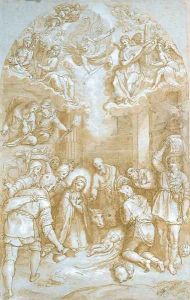Niccol Martinelli, Il Trometta Paintings
Niccolò Martinelli, known as Il Trometta, was an Italian painter of the Baroque period, born in 1603 in Pesaro, a town in the Marche region of Italy. Despite not being as widely recognized as some of his contemporaries, Martinelli made a significant contribution to the art of his time, especially within his local context.
Martinelli's nickname, 'Il Trometta,' which translates to 'the little trumpet,' was likely derived from the surname 'Trombetto' that was present in his family. His father, Pietro Paolo Trombetto, was also a painter, from whom Niccolò presumably received his initial training. Niccolò Martinelli's work was primarily influenced by the dramatic style of Caravaggio, whose tenebrism and realistic approach to human figures defined much of the Baroque aesthetic.
During his career, Martinelli produced religious works for various churches and patrons in Pesaro and the surrounding areas. His paintings often featured intense emotional expressions and a strong use of chiaroscuro, a technique that employs stark lighting contrasts to create a sense of volume and drama.
Despite the quality of his work, Martinelli did not achieve widespread fame, and much of his life remains obscure. The details of his training, the extent of his travels, and the full scope of his oeuvre are not thoroughly documented. However, it is known that he worked extensively in his hometown of Pesaro, where he contributed to the artistic heritage of the city.
Niccolò Martinelli died in 1653 in Pesaro. His legacy persists through the works he left behind, which continue to be appreciated for their emotional depth and technical skill. While Martinelli, Il Trometta, may not have received the same level of recognition as some of his peers, his art provides valuable insight into the regional interpretations of Baroque style in Italy during the 17th century.
